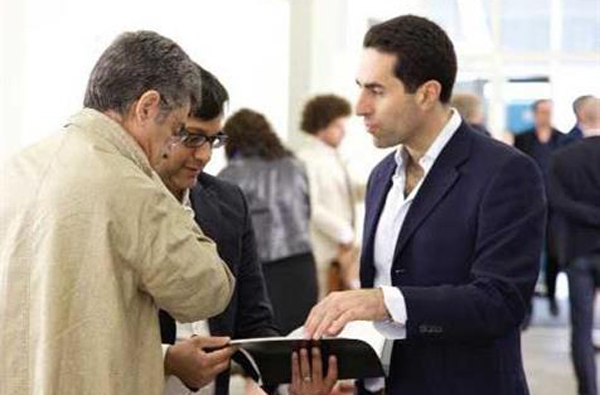The rise of the Art Advisor

With galleries increasingly under pressure, and universities pumping out a stream of arts professionals, other job options are flourishing as emerging collectors are hungry for professional advice. But is Australia following the trend?
They flock to art fairs around the world with clients in tow. They help navigate perceptions of value and nurture collecting tastes. And, they have the opportunity of realising exciting commissions ranging from public artworks, to corporate foyers to architecturally designed homes. Welcome to the world of the Art Advisor.
While we may think this is a relatively new profession, it has been around for hundreds of years. British author Georgina Adam traces it back to the 17th century when the painter Diego Velázquez bought works for King Philip IV of Spain.
America has long been the giant of this profession; however, in recent years we have witnessed a staggering boom particularly within the Asian Market.
We asked Australian Art Advisors their thoughts on this growing profession, and how our local sector sat in context to those international trends?
Annette Larkin, who has been in the business 30-years, said: ‘There are so many more avenues for the purchase of art now – dealer, auction, internet, directly from artists – that more and more new collectors rely on professional art advisors to guide them through the influx of venues.’
Sydney-based Mark Hughes, who worked in the US for many years before returning to Australia, believes that: ‘Australians tend to be self-reliant. It takes a while for people to see the value in getting intelligent and sensitive advice.’
However, he added: ‘People are starting to see that they can call on advice whilst still being in the driver’s seat.’
Melbourne-based Dagmar Cyrulla consulted for 17 years working with emerging collectors before focusing on the leasing edge of the market. She agreed with Hughes that there was a growing need for art advisors and that the collecting landscape had broadened.
Larkin noted, historically, that: ‘During the 2006-2008 boom there were many more art consultants than at any other time. This has fallen quite a bit lately as the demand for collecting has become quieter.’
John Stafford, of the Brisbane consulting duo, CreativeMove, said: ‘I don’t mean to be facetious it’s just that we seem to be such a hybrid business model … And yet there also seem to be a number of us – a somewhat ‘crowded consultancy market’ as I heard it put to me recently.’
The differing comments point to the breadth within the profession, a growing need at the emerging edge of the market while the top tier had tempered. What is interesting is that using an art consultant is no longer reserved for the big-budget heavyweights; and like collectors, consultants too can enter the professional at various levels.
Stafford added: ‘Many of the visual arts consultants that I know are kind of the ‘flux-masters’ of the visual arts eco-system – they tend to operate in between traditional silos such as public galleries and commercial galleries. They may be associated with, but may not actually be members of formalised associations …They exist largely within the ‘commercial’ side of the visual arts but they seem to vary based on their core offering, which may be ‘services’ driven or ‘ideas-entrepreneurial’ driven.’
So what does an art consultant do?
The Art Advisor works within a brief, bridging client with either gallery, artist or auction house in acquiring or commissioning artworks and developing a collection. Their position is much broader than the traditional gallery relationship, working beyond geography and representation.
Allan Schwartzman, of the bluechip New York-based Art Agency Partners, described his role as bridging the gap between ‘how the market likes to appear to function and how it [actually] functions.’
Think of it like an architect – a professional led by training, current trend awareness and innovation, without imposing views upon the client.
It is not about peddling artworks.
So what is the most valuable skill or asset an Art Advisor could hold?
Hughes said: ‘Knowledge and experience! Beware the “art consultant” who has only one or neither. Having an innate sensitive understanding of a client’s needs is also crucial.’
Larkin agreed that building an understanding of the client and what they are looking for is key. ‘This relationship can develop over a year before any artwork is purchased. You have to expose your client to as many different art forms as possible and see what they respond to,’ said Larkin.
Stafford said: ‘Ethics and integrity are essential and so is good judgment’.
A consultant’s knowledge of what is on the market – and most importantly, coming to market – is vital, together with past arts sales, a gift for networking and “an eye” that they trust and build their reputation on.
Essentially you are a freelancer, so a dose of entrepreneurial savvy also helps.
Some consultants come to the profession from a finance or legal background, collectors themselves; an advantage within the climate of purchasing art for investment. Others come from the auction houses with a strong understanding of market and provenance.
‘Each art consultant has their own personal expertise to bring to the table,’ added Larkin. ‘And a collector should seek out the expertise/energy/interests of the consultant that most clearly matches what they are looking for in assisting in building an art collection.’
Just as the consultants vary greatly, so too do the clients. Cyrulla said 90% of her clients were corporate.
There is another edge of consulting and that is as an interface or broker in the public art process between government as client and the artist.
Stafford, whose company focuses more on the government and corporate sectors, said: ‘Public art consultants have also appeared in the private market because local government in particular has become more focused on place-making, cultural tourism, regional identity building, and of course jobs creation in the creative sector for local or interstate artists working in their communities, and also don’t always have the particular expertise in-house.’
‘It is a great career option,’ Cyrulla concluded, ‘especially for those wanting to be involved in the arts without being tied to a gallery space.’
Professional standards:
There are no professional qualifications or degrees specifically for art advisors.
You can do an internet search and any number of sites offer online courses on how you too can be an art consultant, such as this American example that seems to offer everything but the steak knives.
 Sounds like the dream job – www.art-consultant.com promises more than just art.
Sounds like the dream job – www.art-consultant.com promises more than just art.
Jehan Chu, a Hong Kong-based advisor formerly with Sotheby’s, said of the Asian market: ‘There are so many people with business cards that say ‘art adviser’ but they don’t seem to know much.’
In the wake of the recent Art Basel fair, dealer Christophe Van de Weghe, of Van de Weghe Fine Art, said that this problem is not limited to Asia. ‘A lot of [art advisers] are clueless. If buyers are paying you, then you had better be good. When looking at young, cutting-edge work in particular, 99% of the artists will be gone in 20 years.’
In Australia we are more structured. Larkin pointed out: ‘There is the Art Consultants Association of Australia, the Australian Antiques and Art Dealers Association, and Auctioneer and Valuers Association of Australia. These are all associations you can join, but are not prerequisites to calling yourself an Art Consultant or a Valuer.
‘Being an art consultant or advisor doesn’t really need an organisation behind you to approve you. An art consultant is really just a taste maker, so the more understanding you have of art, history, the importance of provenance and condition of an artwork, design and interior decorating, probably the more successful you will be. There are, of course, business ethics one should abide by, but joining these associations doesn’t necessarily guarantee the art consultant will have them. A positive word of mouth is the best accreditation an art consultant can have.’
Testament is Schwartzman’s announced partnership in March with Amy Cappellazzo, who left her post as the Chairman of Christie’s post-war and contemporary art department to consult privately. Heavyweight advisers have a kit of the wealthy and the connected – an enviable list for any young consultant starting out.
It takes years to build that “name” for yourself and, from that perspective, is a career better approached once you have some sector experience.
So how do you choose one?
- Do your research. You wouldn’t buy shares or a house without doing your research.
- Ensure they have a sound art degree behind them.
- Ask a few galleries who they would recommend. Schwartzman advises: ‘Choose someone who is respected by the art dealers you respect.’
- Meet them – in truth personality does play a part. You need to trust this person.
- Be very clear about your timeframe and expectations. If you are commissioning a work the artist’s timeframe must also be considered.
- And sign a contract with them, so all terms are clear and you are fully award of the pricing and commission structure. Some consultants will charge a flat fee for certain services; others work on a percentage of the purchase price, or a combination of both.
- Cyrulla said that she split her rental or leasing fees with the artist. She added: ‘We have to stay flexible to keep up with other pricing in the market. 60/40 is the usual sales split, but again that is flexible.’
- Enjoy the process. You are buying work to enrich you life.
Chu believes: ‘The more they (the client) feel confident to buy on their own, the more I feel I’ve done my job.’
Stafford concluded that we still don’t have a great grasp on the breadth of this sector. ‘Who’s done the research?’
Annette Larkin Fine Art (Sydney) – www.annettelarkin.com
Mark Hughes Art Advisory (Sydney) – markhughesart.com
John Stafford, CreativeMove (Brisbane) – www.creativemove.com.au
Dagmar Art Consultants (Melbourne) – www.dagmarart.com
Art Agency Partners (New York) – www.artagencypartners.com
This piece was first published on artshub.com.au in August 2014.
Leave a Reply
You must be logged in to post a comment.